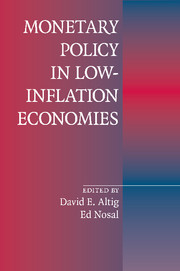Book contents
- Frontmatter
- Contents
- Contributors
- Acknowledgments
- Introduction
- 1 The Welfare Cost of Inflation in the Presence of Inside Money
- Commentary
- 2 An Open-Economy Model of Endogenous Price Flexibility
- Commentary
- 3 Efficient Inflation Targets for Distorted Dynamic Economies
- Commentary
- 4 Inflation and Welfare in Models with Trading Frictions
- Commentary
- 5 Good versus Bad Deflation: Lessons from the Gold Standard Era
- Commentary
- 6 Monetary Policy Orientation in Times of Low Inflation
- Commentary
- 7 Observations on Disinflation in Transition Economies
- Commentary
- 8 Inflation and Financial Market Performance: What Have We Learned in the Last Ten Years?
- Commentary
- Index
Commentary
Published online by Cambridge University Press: 26 January 2010
- Frontmatter
- Contents
- Contributors
- Acknowledgments
- Introduction
- 1 The Welfare Cost of Inflation in the Presence of Inside Money
- Commentary
- 2 An Open-Economy Model of Endogenous Price Flexibility
- Commentary
- 3 Efficient Inflation Targets for Distorted Dynamic Economies
- Commentary
- 4 Inflation and Welfare in Models with Trading Frictions
- Commentary
- 5 Good versus Bad Deflation: Lessons from the Gold Standard Era
- Commentary
- 6 Monetary Policy Orientation in Times of Low Inflation
- Commentary
- 7 Observations on Disinflation in Transition Economies
- Commentary
- 8 Inflation and Financial Market Performance: What Have We Learned in the Last Ten Years?
- Commentary
- Index
Summary
INTRODUCTION
The story in Freeman and Kydland (2000) is this: A modern version of the Friedman and Schwartz (1963) idea is that because the business cycle component of money is positively correlated with the business cycle component of output, we have evidence that money shocks cause business cycles. But if you build a model that captures the reality that consumers can choose between two means of payment, money and deposits, you can get that output and (the sum of) money (and deposits) both rise following a positive productivity shock. When productivity rises, agents want to consume more largeticket goods; for that reason, it becomes more economical to buy things with deposits rather than money (because larger purchases reduce the per-unit costs of using deposits), and banks respond to that demand by creating more deposits. A model with no frictions and no monetary shocks can generate the supposed evidence that money shocks cause output fluctuations.
Freeman, Henriksen, and Kydland present a paper that uses a model of this kind to study the welfare costs of inflation. In this model, as inflation rises, agents shift more of their portfolios into interest-bearing forms to avoid the inflation tax, but they have to pay the additional fixed cost of using interest-bearing deposits in transactions. The authors find that the costs of inflation are small. For example, in their baseline calibration, the gains from reducing inflation from 10% to 3% are about 0.13% (of steady-state consumption).
- Type
- Chapter
- Information
- Monetary Policy in Low-Inflation Economies , pp. 21 - 28Publisher: Cambridge University PressPrint publication year: 2009



